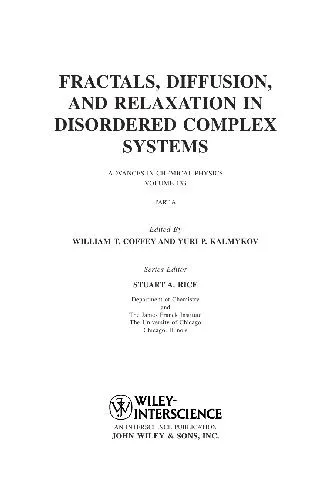Advances in Chemical Physics, Vol.133, Part A. Fractals, Diffusion, and Relaxation (Wiley 2006)
4.5
Reviews from our users

You Can Ask your questions from this book's AI after Login
Each download or ask from book AI costs 2 points. To earn more free points, please visit the Points Guide Page and complete some valuable actions.Introduction to "Advances in Chemical Physics, Vol.133, Part A: Fractals, Diffusion, and Relaxation"
"Advances in Chemical Physics, Vol.133, Part A: Fractals, Diffusion, and Relaxation" is a seminal contribution to the field of chemical physics, exploring some of the most intricate and intriguing phenomena defining the modern understanding of molecular and statistical interactions. Edited and authored by experts Stuart A. Rice, Yuri P. Kalmykov, and William T. Coffey, this volume shines a spotlight on the theoretical and experimental advancements surrounding fractal structures, diffusion processes, and relaxation phenomena. These topics, central to statistical mechanics and physical chemistry, permeate a variety of disciplines ranging from condensed matter physics to biological systems, offering critical insights and applications.
The book is meticulously crafted to address both established theories and emerging concepts, presenting a blend of foundational knowledge and cutting-edge research. It aims to illuminate how fractal geometries influence dynamics, how diffusion governs macroscopic and microscopic behavior, and how relaxation phenomena provide a window into system equilibrium and nonequilibrium dynamics.
Detailed Summary of the Book
This volume meticulously dissects the interplay between fractal structures and chemical systems, serving as a repository of fundamental principles and modern insights. The book is divided into key sections that examine:
- The mathematics of fractals and their characterization, showcasing how self-similar patterns impact physical and chemical processes.
- Diffusion mechanisms, from Brownian motion to anomalous diffusion, and their relevance in systems exhibiting complex dynamics.
- Relaxation dynamics, with an emphasis on how time-dependent decay processes inform our understanding of equilibrium and far-from-equilibrium states.
- Applications of fractals, diffusion, and relaxation in practical scenarios, providing insights into materials science, polymer physics, and biological systems.
Each chapter is written to bridge the gap between theory and practice, offering a cohesive narrative that guides the reader through the nuances of these interrelated domains. The multidisciplinary approach ensures that this volume serves scientists in chemistry, physics, biology, and engineering alike.
Key Takeaways
Here are the core lessons and insights you can extract from this book:
- The profound role of fractals in defining the geometrical and physical properties of complex systems.
- A detailed exploration of diffusion processes, both classical and anomalous, and their implications for reaction-diffusion systems.
- A comprehensive understanding of relaxation phenomena and their relationship to time-dependent behaviors in molecular systems.
- Innovative methodologies and experimental techniques that elucidate fractal, diffusion, and relaxation features in real-world systems.
Famous Quotes from the Book
- "Fractal geometries are not merely mathematical curiosities but integral structures shaping the behavior of diverse systems."
- "Diffusion is the silent orchestrator of microscopic order and chaos, balancing the interplay of random and directed movements."
- "Relaxation is the language through which systems silently narrate their journey toward equilibrium."
- "Understanding complexity necessitates the marriage of new mathematics with old physics, a challenge well-met by fractals and diffusion theory."
Why This Book Matters
"Advances in Chemical Physics, Vol.133, Part A: Fractals, Diffusion, and Relaxation" serves as a cornerstone text for researchers, professionals, and students interested in the cutting edge of chemical physics and statistical mechanics. Its emphasis on interdisciplinary applications ensures its relevance across a variety of scientific fields.
As modern science grapples with increasingly complex systems, the concepts discussed in this book — fractals, diffusion, and relaxation — provide indispensable tools for both theoretical and practical advancements. Moreover, its detailed exposition of theory and its clear linkage to experimental observations make it a must-have for academics, researchers, and industry professionals eager to deepen their understanding of these critical phenomena.
In an era where complexity demands novel frameworks and methods, this book offers clarity, rigor, and innovation, making it a valuable addition to the scientific literature.
Free Direct Download
You Can Download this book after Login
Accessing books through legal platforms and public libraries not only supports the rights of authors and publishers but also contributes to the sustainability of reading culture. Before downloading, please take a moment to consider these options.
Find this book on other platforms:
WorldCat helps you find books in libraries worldwide.
See ratings, reviews, and discussions on Goodreads.
Find and buy rare or used books on AbeBooks.
1124
بازدید4.5
امتیاز50
نظر98%
رضایتReviews:
4.5
Based on 0 users review
"کیفیت چاپ عالی بود، خیلی راضیام"


